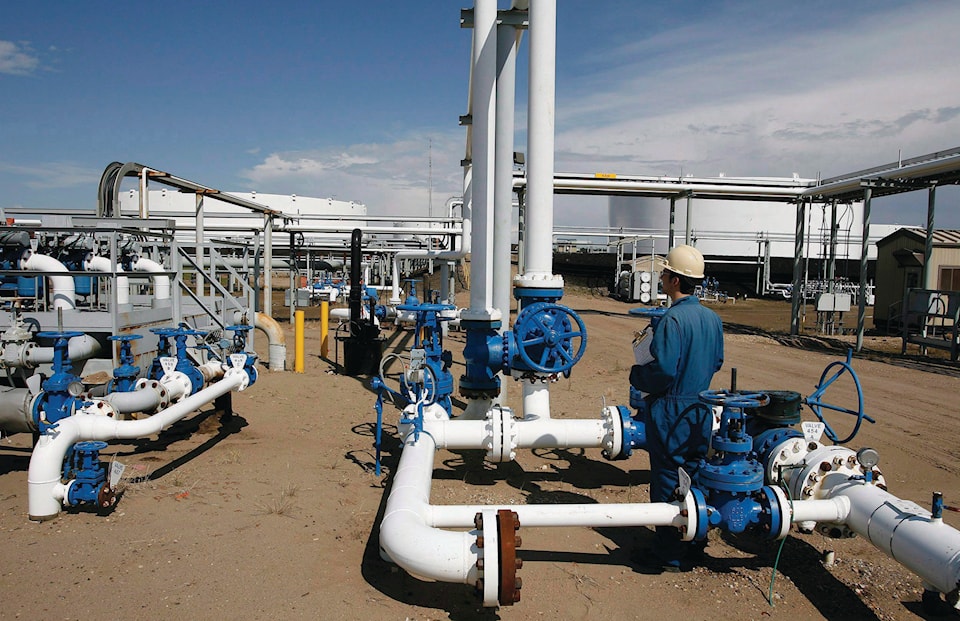A bitter squabble between oilsands producers over the wisdom and outcomes of Alberta’s crude curtailment program continued Friday with CEOs of both Imperial Oil Ltd. and Husky Energy Inc. insisting the move has harmed the industry.
The reductions that started Jan. 1 have met their goal of reducing discounts in western Canadian oil prices, the two agreed, but both complained it has failed to draw down oil in storage and has resulted in fewer barrels being shipped out by rail.
Imperial CEO Rich Kruger said price differentials between Canadian and U.S. benchmarks have gotten so narrow it doesn’t make sense to export crude by rail, which is generally more expensive than by pipeline, to gain higher prices at the delivery point.
He said that’s why the company decided to delay construction of its $2.6-billion Aspen thermal oilsands project in March, after approving it in November, and why it halted almost all crude-by-rail shipments from its co-owned Edmonton rail terminal in February.
“(Storage) tanks were full at the end of the year in the province and the goal was to reduce that inventory so that we had a little more cushion,” said Kruger at the company’s annual meeting.
“Inventories initially declined. With decreased rail, tanks are full again. We’re right back now where we started four or five months ago before curtailment.”
The gains in the price of heavy oil cost Imperial $250 million in higher feedstock prices at its refineries in the first quarter, he said, compared with the fourth quarter of last year when the difference between Western Canadian Select bitumen-blend oil and New York-traded West Texas Intermediate peaked at as much as US$52 per barrel.
Higher local crude prices have come at the cost of oilfield service industry layoffs, poorer rail shipping economics and “unprecedented uncertainty” among investors, said Husky CEO Rob Peabody on a conference call to discuss financial results.
“Industry is shutting in barrels that would otherwise have been economic. This has provoked job losses and resulted in economic hardship for the service sector, which will ultimately reduce the tax base,” Peabody said.
“Whether higher royalties on a diminished production base offset the broader social costs is an open question.”
He and Kruger both called on the newly elected United Conservative Party, set to be sworn in next week, to kill off the curtailment program.
In an email, a spokesman for the UCP pointed out that premier-elect Jason Kenney has previously said he supports the move by the NDP government as an “unfortunate, but a necessary thing to do” and favours gradually reducing the cuts over the coming year.
On Wednesday, Cenovus Energy Inc. CEO Alex Pourbaix told analysts the curtailment program is working well as an oil price support and delivering billions of dollars in additional royalties to the provincial treasury. He said it should be continued until it’s no longer needed.
The curtailment program was initially designed to keep 325,000 barrels per day of oil off the market. That is to fall to about 175,000 bpd by June.
Husky said production in the first three months of 2019 averaged 285,200 barrels of oil equivalent per day, down from 300,400 boe/d in the same quarter last year, due to the Alberta cuts, balanced by the ramp-up of operations at the White Rose field off the cost of Newfoundland.
Imperial said it produced an average of 388,000 boe/d in the first quarter, up from 370,000 boe/d in the same period of 2018, but noted that higher prices received for upstream production were more than offset by reduced downstream profit margins.
It said crude-by-rail shipments averaged 36,000 barrels per day in the first quarter, ranging from 89,000 bpd in January to near zero in February. It averaged 146,000 bpd in the fourth quarter of 2018.
Kruger said Imperial decided to resume rail shipments amounting to about 25,000 bpd in mid-March because of a special opportunity with customers that would allow the company to make a profit, although discounts remain very low.
Earlier this week, the National Energy Board reported that crude-by-rail exports from Canada fell to 131,000 bpd in February from 325,000 bpd in January. They hit an all-time high of 354,000 bpd in December.
Dan Healing, The Canadian Press
